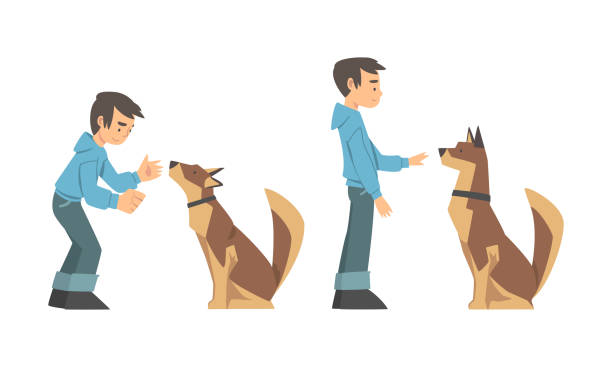
Speak and They Obey: The Power of Voice Tone in Pet Training
Explore whether training pets using only voice tone is effective, backed by expert insights, scientific research, and practical examples showing how vocal cues shape animal behavior and communication.
🐶 Pet Star
30 min read · 29, Jun 2025

Introduction: The Fascination with Voice-Only Pet Training
Pet owners often dream of a world where a simple word or tone can control their pets’ behavior without the need for treats, gestures, or tools. Could voice tone alone be the secret to effective training? This article explores the science behind how animals perceive human vocal cues, the effectiveness of voice tone in training, and real-world applications. We delve into the psychological and neurological mechanisms that enable pets to respond to tone, discuss the limits of voice-only training, and provide expert advice on integrating vocal techniques for optimal results.
Understanding How Pets Perceive Human Voice
The Science of Animal Hearing and Vocal Processing
Animals, especially dogs and cats, have acute auditory capabilities. Dogs can hear frequencies up to 65,000 Hz—far beyond the human range of about 20,000 Hz—which means they can detect subtle vocal nuances imperceptible to us. This heightened hearing allows them to pick up on changes in pitch, volume, and rhythm that form the basis of tone.
Cats also rely heavily on vocal signals but interpret tone differently, often associating it with emotional states such as friendliness or threat.
Emotional Resonance and Tone Recognition
Research shows that animals do not understand the meaning of words but react strongly to tone and emotional content in voice. A study published in Animal Cognition (2019) found dogs can differentiate between praise and scolding tones regardless of the words used, responding more to the affective tone than to lexical content.
Pets pick up on cues such as:
- Pitch: High-pitched tones often signal excitement or encouragement.
- Volume: Louder tones may indicate urgency or reprimand.
- Cadence: Slow, calm tones promote relaxation, while rapid speech can cause agitation.
Does Voice Tone Alone Train Pets Effectively?
Advantages of Voice Tone Training
- Immediate Emotional Communication: Tone can convey approval or disapproval instantly, influencing pet behavior in real time.
- No Need for Physical Tools: Voice-only training simplifies interactions, reducing dependency on treats or clickers.
- Reinforces Bond: Consistent vocal cues can deepen the human-animal bond through clear communication.
Limitations and Challenges
- Lack of Specificity: Tone alone may not convey precise commands, making complex behaviors difficult to train.
- Pet Personality and Breed Differences: Some breeds are more vocal and responsive to tone, while others may ignore vocal cues.
- Environmental Distractions: Noise and other stimuli can interfere with tone perception.
Expert Insights: What Professional Trainers Say
Trainer Perspectives on Voice Tone
Veterinary behaviorists and professional trainers agree that tone plays a critical role but should not be the sole training method.
Sarah Johnson, Certified Professional Dog Trainer, explains:
"Tone is your emotional language with your pet. It tells them how you feel about what they’re doing. But pairing tone with clear commands, gestures, and rewards creates a reliable communication system."
Scientific Studies on Vocal Training
Experiments have demonstrated that dogs trained with consistent tone-command pairings outperform those trained solely by commands or rewards. The emotional content conveyed through tone enhances learning retention and recall.
Practical Techniques for Training Pets Using Voice Tone
Using Tone to Reinforce Positive Behavior
Positive reinforcement is most effective when delivered with a happy, upbeat tone. Saying “Good dog!” in a high-pitched, enthusiastic voice encourages repetition of desired actions.
Calm, Firm Tone for Correction
Using a calm but firm voice to say “No” or “Stop” signals disapproval without frightening the pet, which can lead to better compliance.
Avoiding Negative or Harsh Tone
Harsh, yelling tones may cause stress, fear, or anxiety, hindering training success and damaging the human-animal relationship.
Consistency Is Key
Maintaining consistent tone cues helps pets learn associations quickly and reliably.
Case Studies: Voice Tone Training in Action
Case Study 1: Bella, the Rescue Dog
Bella, a nervous rescue, responded well to positive tone reinforcement combined with gentle commands, showing rapid improvement in obedience and reduced anxiety.
Case Study 2: Max, the Independent Cat
Max ignored most verbal commands but was highly sensitive to calm tone shifts, responding to soft calls by coming when called over time.
Combining Voice Tone with Other Training Methods
Pairing Tone with Gestures and Commands
Voice tone alone is rarely sufficient for advanced training but works best when combined with clear verbal commands and hand signals.
Using Rewards to Enhance Vocal Training
Treats and toys paired with vocal praise strengthen the association between tone and behavior.
The Role of Clicker Training
Clicker sounds can complement vocal tone by providing a precise marker for desired behaviors.
The Psychology Behind Voice Tone and Pet Behavior
Emotional Contagion and Mirror Neurons
Pets often mirror their owners’ emotional states through vocal tone, helping regulate their mood and behavior.
Stress Reduction Through Soothing Voice
A calm, reassuring tone can lower cortisol levels in pets, promoting relaxation during stressful situations.
Common Misconceptions About Voice Tone Training
Myth: Pets Understand Words Like Humans
Most pets respond to tone and body language rather than specific word meanings.
Myth: Yelling Enforces Discipline
Yelling often causes fear and confusion, reducing obedience over time.
Myth: Voice Tone Alone Can Replace All Training
While powerful, tone must be part of a comprehensive training strategy for best results.
The Role of Voice Tone in Training Different Species
Dogs: The Most Responsive Vocal Learners
Dogs have co-evolved with humans for thousands of years, making them particularly attuned to human vocal cues. Studies show dogs can distinguish hundreds of words and intonations, and they often rely more heavily on tone than on specific words. For example, a soft, high-pitched “Come here!” is more inviting than a flat command.
Working dogs, such as police K9s or guide dogs, demonstrate exceptional sensitivity to vocal tone combined with commands, showcasing how tone enhances precision and compliance.
Cats: Subtle but Significant Vocal Sensitivity
Cats are less dependent on vocal commands but still respond to tone changes, often interpreting soft tones as non-threatening and harsh tones as warnings. Unlike dogs, cats rarely obey commands but use tone to gauge owner mood and intent.
Veterinarian Dr. Laura Kim explains,
"Cats respond to vocal tone more emotionally than behaviorally; they may choose to engage or withdraw based on how you sound."
Birds and Small Mammals: Limited but Noticeable Reactions
Parrots and some small mammals like rabbits show an ability to respond to tone cues. Parrots, for example, often mimic tone and pitch and can associate certain tones with specific outcomes, enhancing training efficiency.
The Neurological Mechanisms Behind Vocal Tone Recognition
How the Brain Processes Voice Tone
The auditory cortex in animals plays a vital role in deciphering tone. In dogs, functional MRI studies reveal activation in brain regions related to emotion processing when exposed to different tones, indicating an emotional reaction rather than just auditory processing.
Mirror neurons are also thought to contribute, as they help animals ‘mirror’ emotional states expressed through tone, strengthening bonds and improving communication.
Hormonal Responses to Vocal Tone
Positive tones can trigger the release of oxytocin—the “bonding hormone”—in both pets and owners, fostering trust and cooperation. Conversely, harsh or angry tones may increase cortisol, the stress hormone, which can inhibit learning and cause behavioral issues.
Practical Tips for Mastering Voice Tone in Pet Training
Observe Your Pet’s Reactions
Every pet has unique sensitivities. Pay attention to their responses to different tones—some may respond better to gentle encouragement, while others might need firmer cues.
Practice Consistency
Use the same tone for specific commands or corrections. Inconsistency can confuse pets and delay training progress.
Incorporate Breathing and Pause Techniques
A calm, measured breathing pattern before giving vocal commands can help modulate tone, preventing unintentional harshness or nervousness.
Avoid Overuse of Vocal Commands
Pets can become desensitized to constant vocal cues. Use tone strategically, combining it with non-verbal signals and rewards for best results.
Overcoming Common Challenges in Voice Tone Training
Dealing with Distracted Pets
Environmental distractions can interfere with a pet’s ability to hear and interpret tone. Training in quiet settings initially helps build strong tone associations before gradually introducing distractions.
Addressing Inconsistent Owner Tone
Owners may unconsciously vary their tone based on mood. Recording your voice during training sessions and reviewing it can help identify inconsistencies to correct.
Managing Multilingual Households
Pets exposed to multiple languages may rely more heavily on tone and gestures than words, emphasizing the importance of consistent tone cues across languages.
Conclusion
Training pets using voice tone alone offers a fascinating glimpse into the power of non-verbal communication in human-animal relationships. While pets may not understand the exact words we say, their sensitivity to tone allows them to perceive emotions, intentions, and cues that guide their behavior. Scientific research and expert insights consistently show that tone is a critical tool in effective pet training—helping reinforce positive behavior, discourage unwanted actions, and build stronger bonds.
However, voice tone is not a standalone solution. Its effectiveness depends heavily on factors such as the pet’s species, age, personality, and environment. Dogs, for example, tend to respond well to consistent tonal cues paired with commands and gestures, while cats might be more sensitive to emotional tone than specific training commands. Incorporating tone alongside physical signals and rewards tends to yield the best outcomes.
Moreover, advances in technology and AI promise exciting future possibilities for enhancing tone-based training, making it more precise and accessible. Training apps, voice-activated devices, and AI-driven tone detection could soon become standard tools for pet owners.
Ultimately, voice tone training encourages a deeper, more empathetic connection with pets, fostering mutual understanding that transcends words. For pet owners willing to practice consistency, patience, and observation, mastering voice tone can transform training from a chore into an enriching, harmonious experience.
Q&A on Training Pets Using Voice Tone
Q1: What does training pets with voice tone alone involve?
A1: It involves using changes in pitch, volume, and rhythm to communicate approval, disapproval, or commands without relying on specific words or physical cues.
Q2: Can all pets understand tone equally well?
A2: No, responsiveness varies by species, breed, and individual temperament, with dogs generally more attuned to tone than cats or small mammals.
Q3: Is voice tone more important than words in pet training?
A3: Yes, pets typically react more to the emotional quality of tone rather than the literal meaning of words.
Q4: Are harsh tones effective for training?
A4: Harsh tones often induce fear or anxiety and are generally counterproductive compared to calm, firm corrections.
Q5: How can voice tone enhance positive reinforcement?
A5: Using a happy, enthusiastic tone when rewarding good behavior increases the likelihood the pet will repeat that behavior.
Q6: Should voice tone be the only training method used?
A6: No, combining tone with commands, gestures, and rewards produces the most reliable results.
Q7: Can technology help with voice tone training?
A7: Yes, voice-activated devices and AI can support consistent tone use and provide feedback to improve training.
Q8: How do pets’ brains process voice tone?
A8: Animals’ auditory and emotional brain centers decode tone, linking it to feelings and expected outcomes.
Q9: What challenges exist when training pets using tone?
A9: Inconsistency in owner tone, environmental distractions, and individual pet differences can all reduce effectiveness.
Q10: How can I start training my pet using voice tone?
A10: Begin with clear, consistent tone cues paired with simple commands, observe your pet’s reactions, and adjust tone accordingly.
Similar Articles
Find more relatable content in similar Articles

How Pets Strengthen Family Bonds...
Pets are more than just compan.. Read More

How Climate Change Affects Wild and Domestic Animals...
Climate change is dramatically.. Read More

The Growing Trend of Therapy and Emotional Support Ani..
Exploring the remarkable rise .. Read More

Pets and Mental Health: The Science Behind Emotional H..
Discover the profound impact o.. Read More
Explore Other Categories
© 2024 Copyrights by rPets. All Rights Reserved.